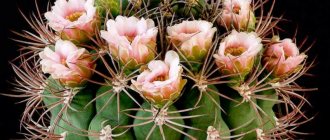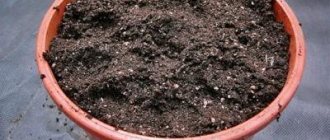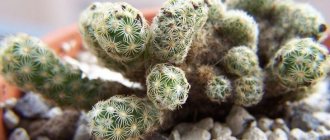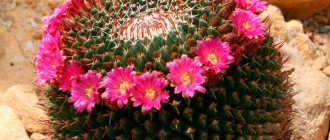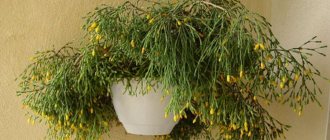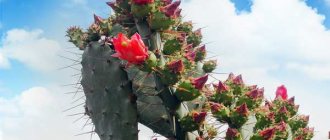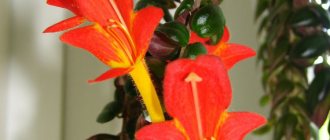Mammillaria is one of the most common cacti that can be grown at home without much effort. Cacti of this species originate from Mexico and southern North America. As a rule, cacti grow on calcareous and chalk rocks. Some species germinate at high altitudes, about 2500 meters above sea level. Plants like to take root in rock crevices, in volcanic tuffs, and some species grow closer to the sea.
Mammillaria cactus is small in size, usually has a round or cylindrical shape, and is distinguished by strong pubescence. Another difference between mammillaria and other species is the small papillae on the stem, from which small spines in the form of hairs sprout. The cactus is quite resistant to hot and cold weather. However, it is noted that there are species of mammillaria that are capricious regarding weather conditions.
Description and features of the cactus genus Mammillaria
Cacti of the genus Mammillaria are numerous representatives of the Cactaceae family. Translated from Latin, the name is interpreted as “tubercle”. The appearance is also attractive precisely due to the original structure of the cactus - the presence of original tubercles or papillae.
The natural habitat of the crop is considered to be the territory of Mexico, as well as Colombia, the USA, and Guatemala. It looks great next to the sea coast. The bushes are quite drought-resistant and are ready to withstand long periods when moisture does not enter the soil.
Cactus Mammillaria in natural conditions of existence
Mammillaria is distinguished by its miniature shape; the stem of the crop is small, but quite fleshy. The shape is spherical, slightly cylindrical, flattened. The diameter of the cactus is up to 0.2 meters, and the height is 0.4 meters. Stems can be single or branching. The top of the bush is covered with papillae that resemble leaves. An areola (bud in the form of a sinus) is formed on top, and a large number of spines and hairs are held on the top of the head.
Mammillaria lacks ribs, like other specimens of this family. Side shoots and flowers are formed in tubercles. The rhizome of the crop is shallow, thickened, and can be fleshy, thick and tenacious.
Mammillaria blooms in spring, when delicate flowers appear in the axils. Flower corollas can be bell-shaped, tubular or disc-shaped. The diameter of the flower is up to 0.06 meters, the petals reach a length of 20-30 millimeters. Shades can be different - snow-white, silver, yellow, beige, pinkish or red. To see full-fledged beautiful flowering, the bush will need a lot of sunlight.
Photo of Mammillaria cactus flowers
The flowering Mammillaria cactus is pollinated by insects or by wind. The formation of the ovary occurs after the end of flowering, and the fruits of the bush usually have a round shape, but can also be club-shaped. They are up to 3 centimeters long and take up to 3 months to mature. The fruits of mammillaria in most cases act as decoration for the bush. When the seed pods ripen, they crack and scatter. The color of the seeds is red, brownish or greenish.
Bloom
This period lasts from spring to autumn. At home, flowering can occur even in winter; at this time, cacti need additional lighting. On average, the daylight hours for a plant should be at least 16 hours. If necessary, special lamps are used. Mammillaria blooms for about six months.
Most cacti have flowers at the top of the central stem. They are presented in the form of a crown. The buds can be white, red, scarlet, crimson, beige, cream, pale yellow. Some species have large flowers 3-5 cm in diameter, and then the cactus produces only 1-3 such flowers.
How to grow Mammillaria cactus at home
A common question among beginning gardeners is how to properly care for cacti. We suggest considering important points in plant care.
Lighting
First you need to decide on the location of the Mammillaria. This cactus is considered to be quite light-loving, but it is better to hide it from direct ultraviolet rays. Therefore, it is recommended to slightly shade the crop during periods of active sunshine.
Mammillaria - a sun-loving plant
In the summer, the ideal solution would be to place a pot with a plant on an open balcony. For indoor growing, choose east or west windows.
Soil composition
The best option would be to buy a ready-made mixture for cacti. If you wish, you can make the composition yourself. For such purposes, peat, turf soil, and leaf soil are used. Sand from the river (coarse enough) and small bricks are also suitable.
Temperature
Ideal indicators for growing such a crop are considered to be from +20...23°C. In winter, this mark should not exceed +12°C. Such conditions will be comfortable for the plant, and it will enjoy long-lasting flowering.
Cactus care information
What soil is needed to grow cacti?
How to water cacti correctly to avoid mistakes in care
How to properly use fertilizer for cacti at home
Hydration
The plant will require a minimal amount of moisture. In winter, you can generally leave it without moisture for a long time. In the summer season, it will be enough to carry out 3-4 waterings per season. The best option for watering a mammillaria cactus in the autumn is to carry out the procedure up to 2 times every 30 days. You can spray the crop, especially pay attention to this issue in the hot season.
Fertilizer
Starting from mid-spring until autumn, you will need to feed the bush. In winter, such a procedure is not necessary. It is recommended to add nutrients up to 1 time per season. Thanks to this approach, the plant will fully develop.
Mammillaria transplant
Special attention is paid to how to replant the Mammillaria cactus. Adult plants need this procedure up to once every 3 years. Young bushes can be planted in new containers every year. To do this, choose wide but shallow containers. Be sure to lay a drainage layer on the bottom, and only then place the soil composition. Usually, the Mammillaria cactus is transplanted in the spring.
How to replant?
For mammillaria, you should purchase a wide but shallow pot (ceramic or plastic), making large drainage holes in it. Expanded clay or brick chips are placed at the bottom of the container, then filled with soil substrate.
Young plants are replanted annually, and adults - once every 2 years. Transplantation is carried out in the spring.
You can plant different varieties of cacti in one container, creating an original mix.
Methods of reproduction of Mammillaria
For propagation, plants use seeds and side shoots.
The use of side shoots or children requires careful approach and care to avoid damage to the adult crop. Before planting in a separate container, you will need to first dry the young shoot. To plant children, use miniature containers.
Video of Mammillaria cactus propagating by lateral shoots
To sow seed, mix the soil with sand, place the seeds on top, followed by a layer of sand. Water moderately enough, and then place the container in a warm room, where the air temperature should be up to +20°C. It is extremely important that the crops are not exposed to sunlight. When the first shoots form, boxes with crops are placed in a room with good lighting.
General description with photo
Mammillaria is a succulent from the vast Cactus family, diverse not only in shapes and colors, but also in preferred growing conditions. Some species of this cactus are found primarily in hot deserts, while others prefer cool mountains, sea coasts or dry limestone mounds. However, this does not create additional difficulties when growing mammillaria at home, since its temperature requirements are reduced to ensuring the difference between daily temperatures, characteristic of a dry, sharply continental climate.
A distinctive feature of the genus is the tubercular structure of the body; its stem is strewn with tubercles-papillae (mammillae), called tubercles. Most varieties of mammillaria are small in size; there are also very miniature representatives. The shape of the fleshy stem is usually spherical; with age, it may stretch upward to become ellipsoidal-cylindrical. Flat-oblate varieties and short-cylindrical forms are less common, but they are more in demand in home floriculture. The stem can be single or have numerous branches. Tubercles are modified leaves, at the ends of which there are areoles with a tuft of soft pubescence and/or spines. They can sit very tightly or loosely, in any order. Mammillaria does not have ribs, like many representatives of cacti. The root system is shallow, the roots are fleshy, shortened, tenacious.
Common growing problems
Among crop pests, the red mite is considered the most dangerous. To combat the parasite you will need Actellik. A popular problem when growing crops is the strong stretching of the bush towards the light source, this leads to damage to the crop. Therefore, try to choose comfortable conditions for the culture.
How often the Mammillaria cactus blooms depends primarily on proper care. By following all the recommendations, you will be able to get a spectacular and attractive bush that produces flowers almost continuously.
Diseases and pests
Dangerous pests are spider mites, red mites, and catus scale insects. Insecticides, Actellik solution, Tanrek, Vertimek are effective in combating them.
One of the folk remedies for pest control is a soap solution - a flowerpot:
- The window sill is treated with a foamy soap solution, and the plant itself is sprayed.
- Soap suds are washed off the cactus after 3-4 hours.
Treatment with insecticides must be carried out at least 3 times. Pest eggs are especially resistant to damage.
When overwatering, gray rot is a frequent unwanted guest. Only pruning can save a cactus; replanting is powerless in most cases.
Mammillaria cactus: plant varieties
There are quite a few types of crops, but we suggest focusing on the most interesting and popular among flower growers:
Mammillaria prolifera
It is also called M. prolifera. It is distinguished by a spherical stem, up to 0.06 meters high. The shade is dark green. The papillae are round in shape with slight pubescence.
Photo of Mammillaria runner or growing
The flowers grow up to 1.4 centimeters in length, they usually have a creamy-yellowish tint, with a pinkish stripe in the center of each petal. This beauty blooms for 2-3 months, usually in spring. A characteristic feature is self-pollination of the crop. The fruits are usually orange-reddish in color.
Mammillaria wildii
The length of the stem is usually up to 5 centimeters. The papillae are usually elongated, with golden spines. This variety is often referred to as white mammillaria because it has white petals.
Mammillaria Wilda
The species is distinguished by its branchiness. Berries are formed only after repeated pollination. The shape of the central spine is usually curved.
Colombian Mammillaria (Mammillaria columbiana)
The cactus reaches a height of 15-30 centimeters. The stem is usually narrow, cylindrical in shape.
Mammillaria columbia
The flowers are small, dark pink in color, with a little fluff sticking out slightly on them. The fruits have a traditional orange hue.
Mammillaria elongata
It has a cylindrical stem, its height is up to 4 centimeters. The spines form an original rosette of a golden hue.
Mammillaria elongata
The flowers are characterized by white petals. The needles are also white.
Types and varieties
All types have decorative value, many are popular in indoor culture, and new varieties are appearing. The species of mammillaria is constantly being replenished; such cacti are convenient for beginners because they are unpretentious in care. The most popular are:
- Golden-haired. Mexico is considered the birthplace of this variety. A single dark green stem has a height of 4-6 cm. This species has a slightly flattened ball shape with a diameter of up to 6-8 cm. The root is thick, fleshy, dense. There are no thorns on the cactus, but there are hair-like thin white needles and threads. Flowering occurs with bell-shaped flowers up to 3 cm in diameter. The petals of the plant are beige or cream, they have a pink longitudinal stripe.
- Bokasana. The species has dense cylindrical stems up to 4-6 cm tall, dark green in color. The plant's thorns are dark, have hooks at the tips, and are framed by a tuft of long white hair. Mammillaria bocasana has a wreath of pinkish bell-shaped flowers during flowering. If you provide good care, flowering will occur every year.
- Wilda. The stem of the plant is barrel-shaped, dark green, up to 3-5 cm in diameter. The tubercles are short, elongated. On the central hook-shaped hard spine there are thin, thread-like spines. Mamillaria wilda usually has many lateral shoots up to 2 cm long, which grow and develop on the mother trunk without falling off. When flowering, white flowers with a bright yellow center appear.
- Bokasanskaya. The stem of the cactus is oblong and thick, 4-5 cm in diameter. The tubercles are oval, elongated. The cactus has many shoots. From the rosette on the tubercles grows a hard, hook-shaped spine, which is framed by light hair-like spines. During flowering, white small buds appear, seeds-berries are formed after cross-pollination.
- Zeilman. The plant has small bright pink flowers. It blooms for 6 months. The stem of the cactus is round or short cylindrical. The central spike with a hook has a bunch of white thin spines.
- Runaway. This species has side shoots and small rounded stems. The spines are hair-like, needle-shaped, golden in the center of the rosette, and white at the edges. The shoot-bearing species has white flowers.
- Carmen. The plant is highly branching and quickly forms groups. The stem of the plant is elongated, oval, dotted with short dark yellow or brown spines. When flowering, Mamillaria carmen has many white flowers.
- Zelman. The stems of young plants are spherical, gradually stretching to 6-7 cm in length and up to 15 cm in diameter. Side shoots appear at the base. Tselmana is a beautifully flowering cactus; the flowers are large, 2.5-3 cm each. Flowering begins in spring and lasts until autumn. This species is unpretentious, so it is ideal for beginners.
- Luti. A miniature species with short, dark green, pear-shaped stems. There are few spines and they are located rarely. Mammillaria luti has large flowers, 2-3 buds on one stem, the tips are lilac or purple at the base.
Mammillaria bocasana (M. bocasana)
My most insidious mammillaria. I got it as a little child. Before this, I took care of the mother plant. Only because the adult plant looks simply gorgeous did I decide to get one for myself. Cute fluffy, but only until you decide to transplant him. Under the white fluff there are many hook needles that turn her into a real monster.
The species is named after its habitat in the Bocas region (Mexico).
This is a very densely pubescent plant that blooms with small white flowers. The flowers are easy to miss, as they are not very visible due to the edge.
I can say that this insidious baby is very unpretentious and grows quite quickly. The growth rate increases with age.
Mammillaria hidalgensis
Of my mammillaria, this one promises to become a real giant.
July 2013
Mammillaria Hidalga attracted me with its very decorative appearance and the virtual absence of thorns.
August 2013
This species grows very quickly and reaches considerable sizes. Up to 30 cm in height and 33 cm in diameter.
It is in her example that all the structural features of mammillaria are clearly visible. It also blooms quite readily.
The flowers, although small, have a very rich color.
The life of a flower is also not long. Just a couple of days.
First day of flowering.
September 1, 2013
Second day of flowering. The petals are curved.
As long as she makes me happy. I'll see what happens next.
How to properly transplant mammillaria after purchase?
This cactus is tolerant of transplantation, so after purchasing a ready-made specimen, you can transplant it from a temporary sales container into a permanent pot in 1-2 weeks. It is better to do this by transshipment with the addition of the required amount of specialized substrate for succulents. The presence of a coarse-grained drainage layer is mandatory!
It is better to moisten the soil with a spray bottle in advance than to water an already transplanted cactus.
Planned mammillaria transplant
The cactus itself grows slowly, but can produce an extensive increase in children. If they feel cramped in a pot, they are seated in different containers or in one, but wider one. During transplantation, the children are separated with a knife, followed by drying the cut. There is no need to bury them when planting; just screw them lightly into the ground. To ensure stability, young seedlings are surrounded with stones.


